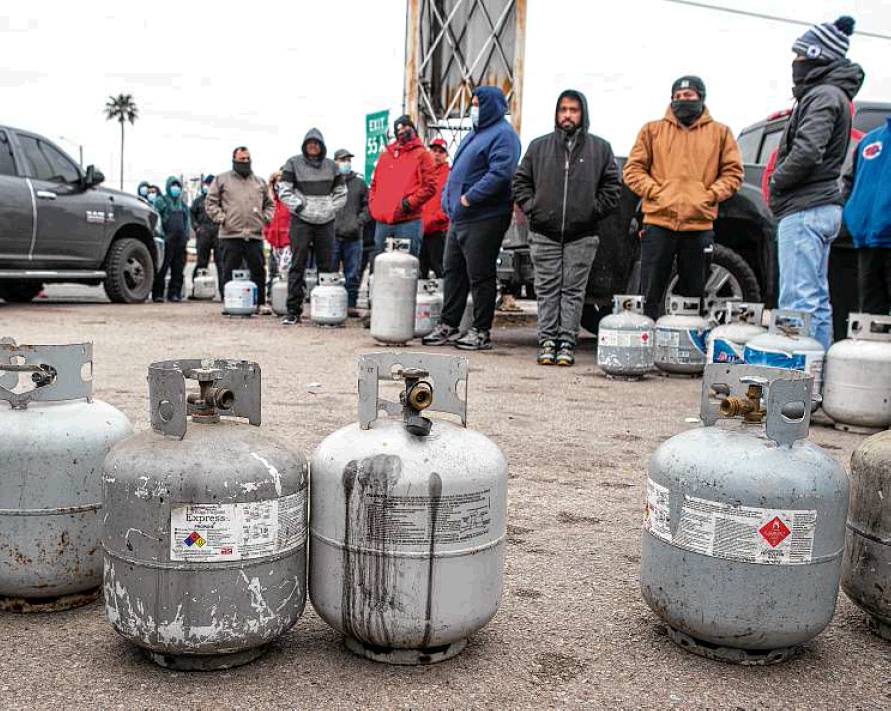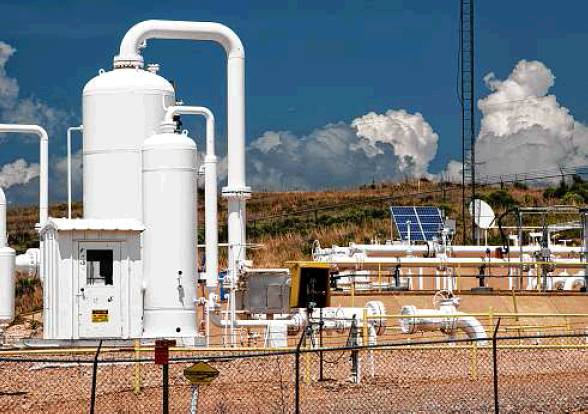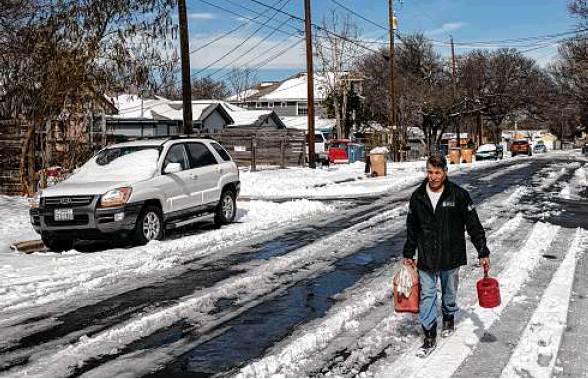Recent cold snap heats up debate about power grid
Environmentalists, industry clash over natural gas system
By Shelby Webb STAFF WRITER
A week since temperatures dipped below freezing in Houston — and almost a year after the deadly February blackout — a spat has erupted again over the ability of the state’s natural gas operations to withstand severe cold and keep the power grid running.
On one side are environmentalists and other watchdogs who say that initial data released in the wake of the cold that spread over Texas in the first days of 2022 showed flaws in the state’s natural gas framework. Bloomberg reported that 1 billion cubic feet of natural gas had been flared as operators dealt with the cold. That number was later revised to 1 million cubic feet. S&P Global released a report Jan. 3 indicating that natural gas production in the Permian Basin dropped by 20 percent as temperatures there dipped into the teens the day before.
But as more data became known, natural gas proponents said the numbers painted a different picture. The U.S. Energy Information Administration estimated that average natural gas production in the Permian that week fell by 800 million cubic feet per day, a 5 percent decline from the previous week. But the Texas Oil and Gas Association said analytics company RBN Energy found that there may have been a 22 percent decrease at the worst of the recent cold.
With the disparate data, natural gas industry proponents say environmentalists have overblown the risk of another freeze knocking out much of the natural gas supply, while watchdog groups say the industry has done too little to prepare for another winter storm.
“The truth is somewhere in the middle of that, as normally you would expect,” said Charles McConnell, executive director of the University of Houston’s Center for Carbon Management and Sustainability and a former U.S. assistant energy secretary.
How gas lines freeze
McConnell said freezing issues with natural gas tend to start at the beginning process. Natural gas is funneled from its source to lines that transport it to compressor stations. In this early stage, the gas still contains water, he said, allowing it to freeze when temperatures dip below 32 degrees. Compressor stations also can freeze because they’re filtering the moisture-laden gas.
Still, he said, chemical engineers are not surprised when raw natural gas moves 20 percent more slowly through pipelines during freezes, and the gas and power scheme in Texas doesn’t help. He said Texas natural gas producers aren’t required to weatherize their equipment to standards that would survive another deep freeze, nor are they provided any financial incentives to do so.
“All of those decisions are left to the private market to make determinations for what’s best for their shareholders, and that’s OK for most of the time for most commodity industries,” he said. “But when we’re talking about electricity, or keeping people’s houses warm, it’s something for the good of the public.”
About 10,030 megawatts of power, 11.7 percent of the state’s power generation capacity, were knocked offline from Dec. 31 to Jan. 3, according to the Electric Reliability Council of Texas, the state’s grid manager. About 996 megawatts, less than 10 percent of that lost power, came from natural gas plants that were unable to get the gas they needed to run. One megawatt is enough electricity to power about 200 homes on a hot summer day.
The Public Utility Commission of Texas, which oversees ERCOT and creates rules for its power market, is retooling the state’s deregulated power market. Among the changes: a reduction in the maximum price for one megawatt-hour to $5,000 from $9,000 and fines of up to $1 million per day per violation for electricity generators that can’t meet new weatherization requirements. PUC Chairman Peter Lake said those changes, among others, will ensure “ the lights will stay on,” this winter.
“No other grid has made so many changes in such a short amount of time as we have,” he said at a December news conference.
And during the most recent cold snap, the grid seemed to work. ERCOT did not ask Texans to conserve electricity because of shortages, and it didn’t have to dip into its reserve margins to meet the state’s power demand.
Gas and the grid
Still, natural gas generation plants accounted for more than 51 percent of all forced outages during the New Year’s cold. Most of those issues lie with the natural gas generators, said Todd Staples, president of the Texas Oil and Gas Association. And some of the fuel-led-generation failures, he said, may boil down to the power plants and not the natural gas providers — but it’s too early to know.
But, he said, the early numbers from environmental groups and other watchdogs misrepresented the reality on the grid.
“Anyone drawing those types of conclusions from this event is creating hysteria based on incorrect facts, and that’s a dangerous way to talk about the issues,” he said. “It affects how policy is decided, how markets react and how individual consumers react. These major exaggerations are just dangerous to all Texans.”
Cyrus Reed, conservation director for the Lone Star Chapter of the Sierra Club, disagreed. He said that while the more recent freeze was not nearly as bad as the February storm, it still exposed shortcomings. The organization said more than a dozen facilities released excessive levels of pollution during the cold spell.
“Obviously it did not cause major issues to the grid, but the fact that a relatively small freezing event that lasted one or two days caused that many emission events and several power plants were not able to operate as a result is a major concern,” he said.
Are changes enough?
Some regulations have changed since the last winter storm, though not nearly as much as power watchdogs would like to see.
Natural gas facilities deemed critical by the Railroad Commission of Texas, which oversees the state’s oil and gas industry, are now required to register with ERCOT so their power is not cut off in emergencies.
That regulator is mulling more changes, as mandated by state legislative action, and the PUC has ordered more substantial weatherization practices for power generators. Among those mandated by the PUC are sheltering critical systems from wind, insulation inspections and establishing emergency testing schedules.
Still, McConnell with the University of Houston and Reed with the Sierra Club say more will be needed to ensure that Texas’ grid will be reliable during extended freezes.
McConnell said it will take more wholesale changes to the state’s power market — which is under review by the PUC — or legislative changes to ensure that the blackouts of 2021 won’t be repeated.
“If you don’t solve the problem, you’re going to keep having the issues,” McConnell said. “It’s just that simple.” shelby.webb@chron.com


